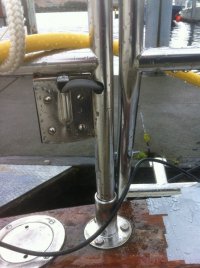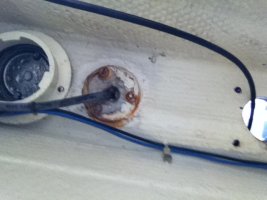Have a look at the attached pics (from above and below). I've got water coming through the hole which feeds the wire to my aft nav light. This travels down the tube of the stanchion, drops onto the bottom of the locker, then drains down to and around the base of the steering shaft then into my aft cabin, soaking my bed.
So……..
Any thoughts? Where is the failure? Is there supposed to be a watertight boot or some such lining the wire hole to keep out the water? How would you fix this?
And since we're there, I probably ought to re-bed the stanchion base. How does one do this in the case above where it it is on top of a layer of both wood and fiberglass?
Thanks!
Ed
'91 E-34 "Kinnaree"

So……..
Any thoughts? Where is the failure? Is there supposed to be a watertight boot or some such lining the wire hole to keep out the water? How would you fix this?
And since we're there, I probably ought to re-bed the stanchion base. How does one do this in the case above where it it is on top of a layer of both wood and fiberglass?
Thanks!
Ed
'91 E-34 "Kinnaree"

Attachments
Last edited:

